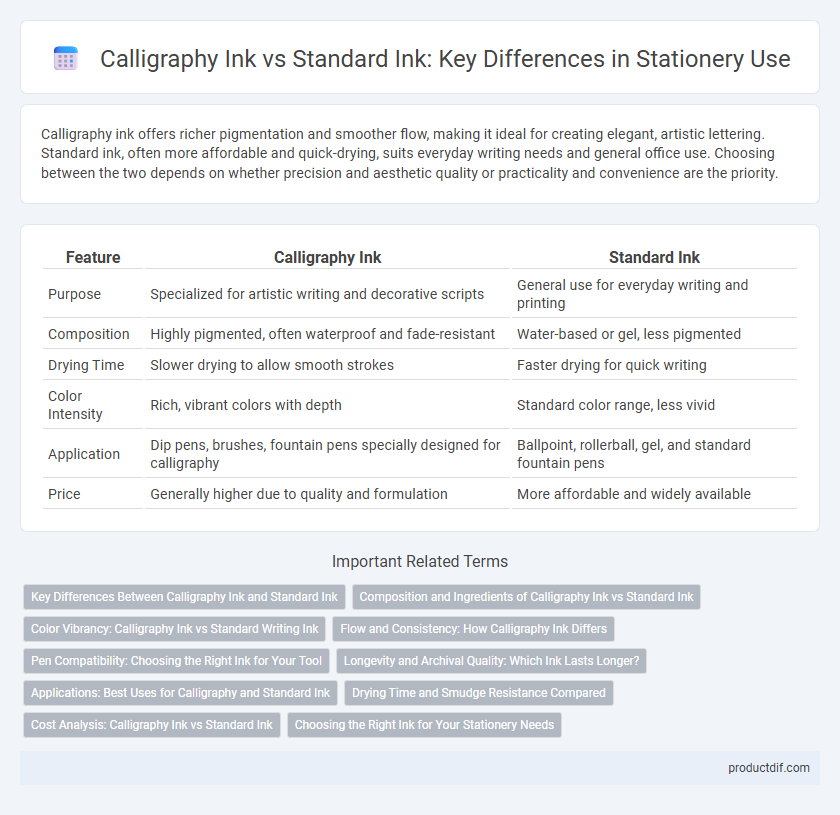Calligraphy ink offers richer pigmentation and smoother flow, making it ideal for creating elegant, artistic lettering. Standard ink, often more affordable and quick-drying, suits everyday writing needs and general office use. Choosing between the two depends on whether precision and aesthetic quality or practicality and convenience are the priority.
Table of Comparison
| Feature | Calligraphy Ink | Standard Ink |
|---|---|---|
| Purpose | Specialized for artistic writing and decorative scripts | General use for everyday writing and printing |
| Composition | Highly pigmented, often waterproof and fade-resistant | Water-based or gel, less pigmented |
| Drying Time | Slower drying to allow smooth strokes | Faster drying for quick writing |
| Color Intensity | Rich, vibrant colors with depth | Standard color range, less vivid |
| Application | Dip pens, brushes, fountain pens specially designed for calligraphy | Ballpoint, rollerball, gel, and standard fountain pens |
| Price | Generally higher due to quality and formulation | More affordable and widely available |
Key Differences Between Calligraphy Ink and Standard Ink
Calligraphy ink features higher pigment concentration and smoother flow, designed specifically for detailed strokes and varied line widths, unlike standard ink which is formulated for everyday writing with consistent flow and quick drying. Standard ink often lacks the vividness and opacity of calligraphy ink, which enhances the visual impact of artistic lettering. Durability and archival quality are stronger in calligraphy inks, making them preferable for professional art and formal documents.
Composition and Ingredients of Calligraphy Ink vs Standard Ink
Calligraphy ink features a higher concentration of pigments and a thicker viscosity compared to standard ink, allowing for smoother, more precise strokes essential for artistic lettering. Its formula often includes water-resistant and fade-resistant ingredients like shellac or gum arabic, enhancing durability on various paper types. Standard ink, by contrast, contains lighter pigments and more water-based solvents, resulting in faster drying times suited for everyday writing but less resilience and vibrancy.
Color Vibrancy: Calligraphy Ink vs Standard Writing Ink
Calligraphy ink offers superior color vibrancy compared to standard writing ink, delivering richer and more saturated hues that enhance artistic expression. Its pigment concentration and specialized formulation create bold, vivid lines that retain intensity on various paper types. Standard writing ink tends to be lighter and less intense, designed for everyday use rather than vibrant, decorative writing.
Flow and Consistency: How Calligraphy Ink Differs
Calligraphy ink exhibits a thicker consistency and smoother flow compared to standard ink, allowing for precise, elegant strokes essential in artistic writing. Its formulation includes pigments and binders that prevent feathering and bleeding on specialized paper, ensuring clean edges and color vibrancy. Standard ink, often water-based and thinner, dries quickly but may lack the controlled flow necessary for intricate calligraphy details.
Pen Compatibility: Choosing the Right Ink for Your Tool
Calligraphy ink is specially formulated for dip pens and fountain pens, offering smooth flow and vibrant pigmentation that enhances decorative writing and artistic projects. Standard ink, commonly used in ballpoint and rollerball pens, is designed to dry quickly and resist smudging on everyday paper surfaces. Selecting the right ink depends on your pen type, as using calligraphy ink in standard pens can cause clogging, while standard ink in calligraphy tools may result in poor flow and uneven lines.
Longevity and Archival Quality: Which Ink Lasts Longer?
Calligraphy ink typically contains higher-quality pigments and binding agents that enhance its longevity and archival quality compared to standard ink, which often relies on dye-based formulations prone to fading over time. Archival-grade calligraphy inks are designed to resist discoloration, water damage, and degradation, making them ideal for important documents, artwork, and formal settings. Standard ink may perform adequately for everyday writing but lacks the durability required for preservation and long-term legibility.
Applications: Best Uses for Calligraphy and Standard Ink
Calligraphy ink is specially formulated for smooth, consistent flow and vibrant pigmentation, making it ideal for artistic lettering, formal invitations, and decorative writing where precision and visual impact are essential. Standard ink, commonly used in ballpoint and gel pens, suits everyday writing tasks such as note-taking, office documents, and schoolwork due to its quick-drying properties and durability on various paper types. Choosing calligraphy ink enhances projects requiring elegance and intricacy, while standard ink excels in practical, high-volume writing applications.
Drying Time and Smudge Resistance Compared
Calligraphy ink typically features slower drying times due to its higher pigment concentration, allowing for smoother, more expressive strokes. Standard ink dries faster, reducing the risk of smudging, which is ideal for everyday writing tasks. Calligraphy ink offers superior smudge resistance once fully dried, enhancing the durability and visual appeal of fine lettering compared to standard ink.
Cost Analysis: Calligraphy Ink vs Standard Ink
Calligraphy ink typically costs more than standard ink due to its specialized formulation, which includes higher-quality pigments and additives for better flow and permanence. Standard ink is generally more affordable, produced in larger quantities, and designed for everyday writing tasks, making it suitable for bulk purchases. When comparing cost-effectiveness, calligraphy ink justifies its higher price through enhanced performance and aesthetic quality, whereas standard ink offers greater value for routine use and large volumes.
Choosing the Right Ink for Your Stationery Needs
Calligraphy ink offers rich pigmentation and smooth flow ideal for artistic writing, while standard ink suits everyday use with quicker drying times and cost efficiency. Selecting the right ink depends on your project's purpose, whether requiring vibrant, long-lasting color for invitations or practical, fast-drying ink for note-taking. Consider factors like paper type, pen compatibility, and drying time to optimize the performance and appearance of your stationery.
Calligraphy ink vs Standard ink Infographic

 productdif.com
productdif.com